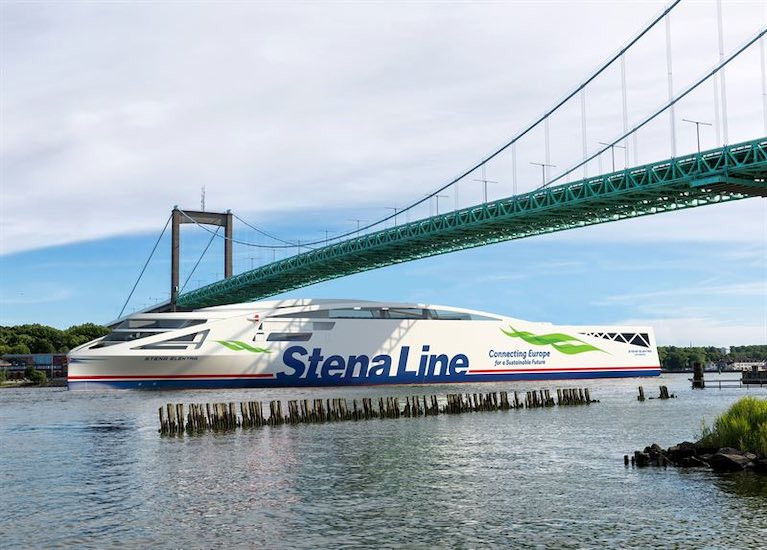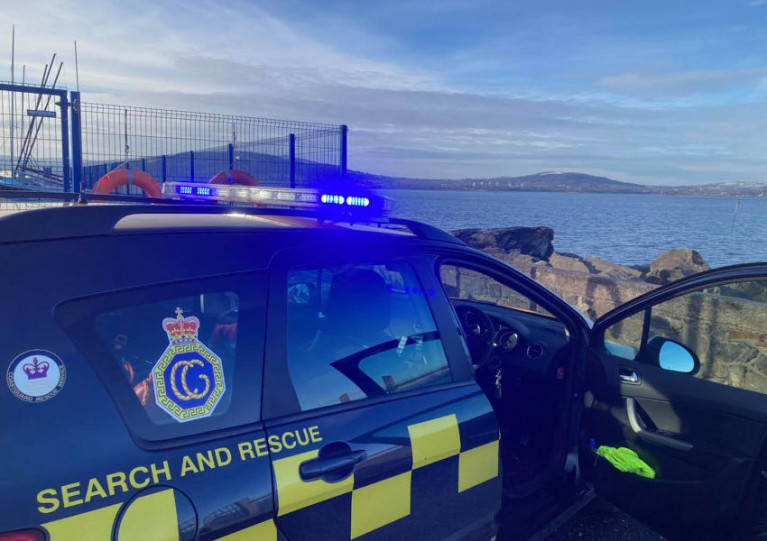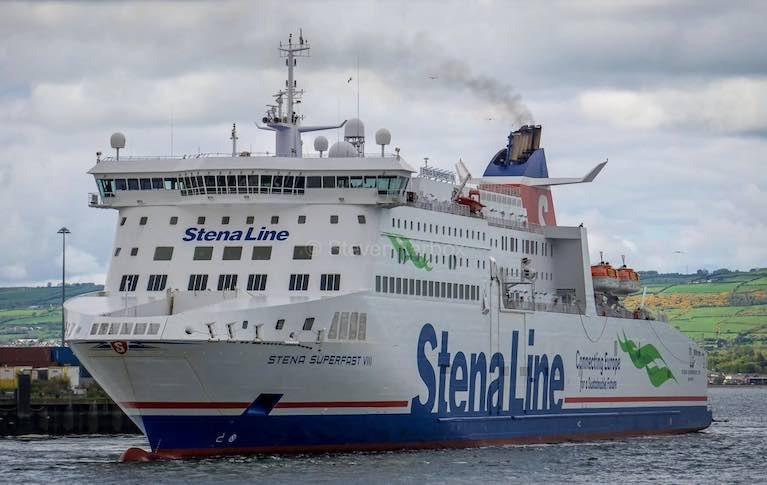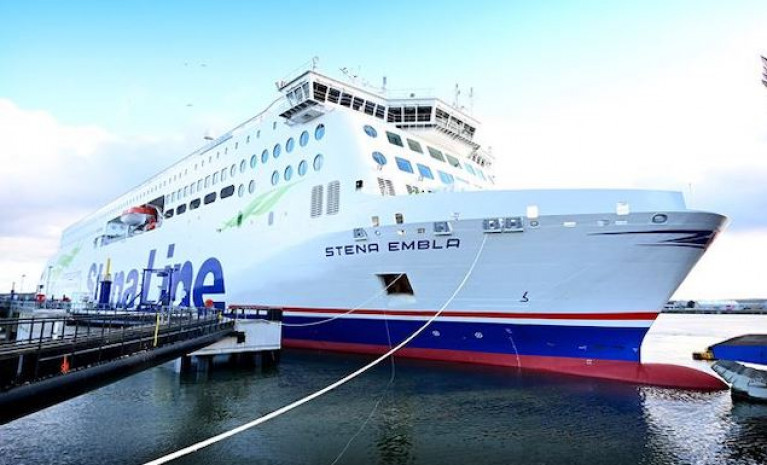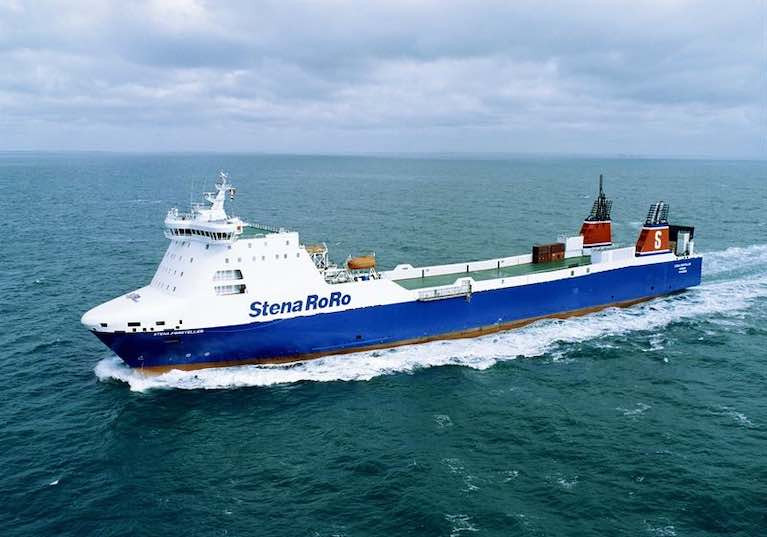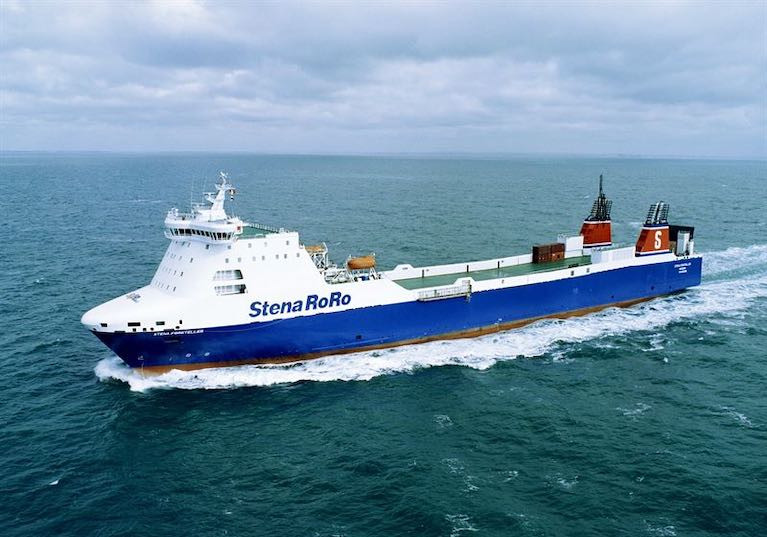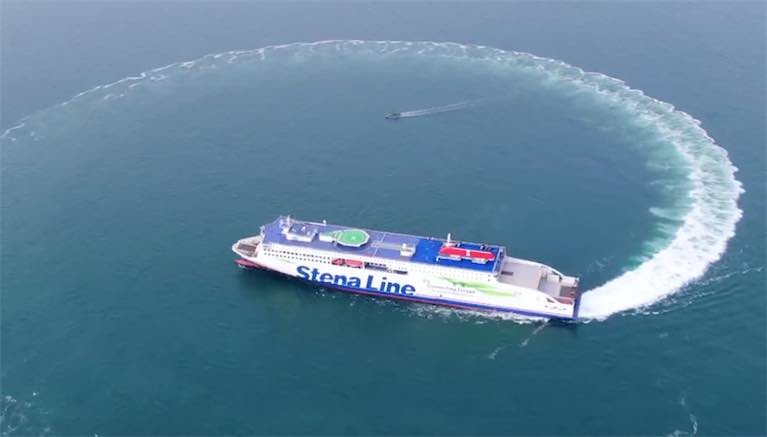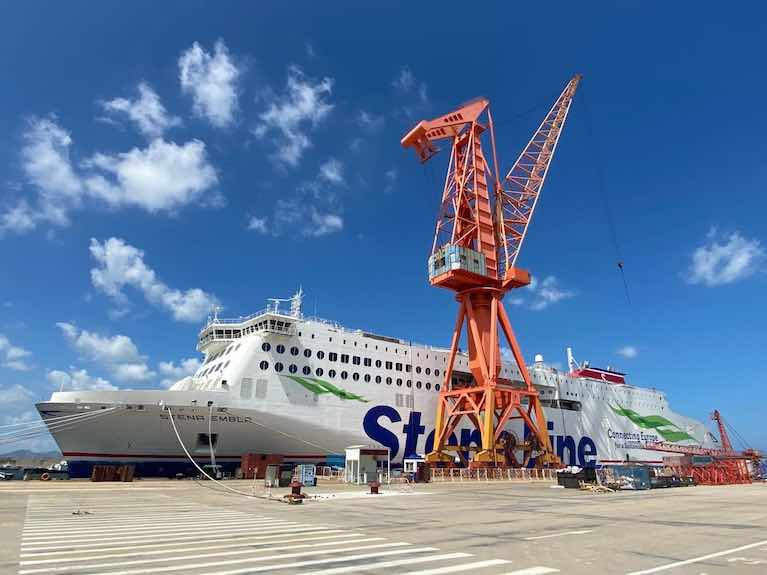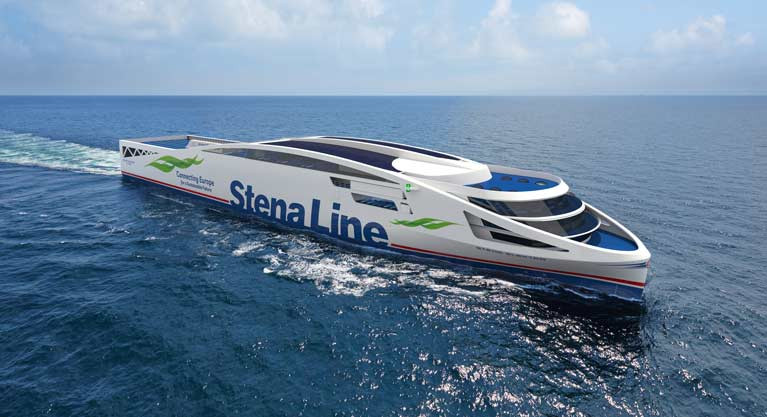Displaying items by tag: Stena
Fog Curtails Dublin Bay Boating Activity on First Weekend of Spring Sunshine
A Dublin Bay sea mist that lay in the middle of the bay most of the morning had enveloped most of the south shore by lunchtime, reducing visibility down to 50 metres or less at Dun Laoghaire Harbour.
The morning had seen a large number of different types of pleasure craft enjoying the bright sunshine and calm conditions.
Met Eireann had forecast Northeast or variable force 3 winds with some patches of mist or fog.
There were groups of different dinghy classes, sailing cruisers as well as fishing boats, jet skis and motor cruisers all enjoying one of the first weekends of 2021 afloat.
 The Stena Ferry disappears in the mist Photo: Barry O'Neill
The Stena Ferry disappears in the mist Photo: Barry O'Neill
Canoeists and paddleboarders and rowing boats hugged the shore at Scotsman's Bay as the mist grew thicker.
There were plenty of swimmers and day-trippers sampling the admittedly very cold February waters of just 7 degrees.
The extent of the mist meant that by 2.30 pm there most boating activities were kerbed with the fog lifting just after 4 pm.
Stena Line Plans to Launch Fossil Free Ships Before 2030
Ferry company Stena Line plans to start operating two fossil-free battery-powered vessels on the route between Gothenburg and Frederikshavn in Denmark no later than 2030. This was announced by Stena Lines CEO Niclas Mårtensson during a press conference about the industry collaboration project Tranzero Initiative, in Gothenburg on Thursday 4 February.
In an effort to speed up the transition to fossil-free fuels in the transport sector, Stena Line together with Volvo Group, Scania and the Port of Gothenburg have joined forces in the Tranzero Initiative collaboration project to bring about a significant reduction in carbon emissions linked to the largest port in the Scandinavia. The aim is to cut emissions by 70 per cent by 2030 in the Port of Gothenburg.
During a press conference about the Tranzero Initiative on Thursday, 4 February, Stena Line CEO Niclas Mårtensson announced the company´s plans to launch two fossil-free vessels on the Gothenburg-Frederikshavn route before 2030.
“We now move from vision to vessel with the battery-powered vessel Stena Elektra. Within a year we will present the outline specifications and at the latest by 2025, we plan to order the first vessel. This will be a huge step towards fossil-free shipping”, said Niclas Mårtensson, CEO Stena Line Group and member of the Swedish Government Electrification Commission.
Stena Elektra will be the world’s first fossil-free RoPax vessel of its size and will measure approximately 200 metres and combine a passenger capacity of 1000 with 3000 lane metres freight capacity. The vessel will be built in high tensile steel to lower the weight and increase efficiency and it is estimated the vessel will run on battery power for approximately 50 nautical miles, the distance between Gothenburg and Frederikshavn. The battery capacity will need to be approximately 60-70 MWh and the vessel will be charged in port. Stena Line also looking into combining the electrification with other alternative fossil free fuels such as fuel cells, hydrogen and bio methanol for longer reach of the vessels.
”The electrification of shipping has only just begun. We see a great potential for both battery hybrids and battery-powered vessels on several of our short-sea shipping routes in the future. But, it takes more than the electrical ships, we also need to develop the infrastructure and charging possibilities in the ports and terminals in the same pace and that is a reason why collaborations projects like this are so important, said Niclas Mårtensson, CEO Stena Line.
Battery hybrid already operating
Since 2018 Stena Line is operating the battery hybrid vessel Stena Jutlandica on the Gothenburg-Frederikshavn route, using battery power for manoeuvring and powering the bow thrusters when the ship is in port. The batteries are charged with green shore power in port of Gothenburg as well as during operation and in total the CO2 emissions are lowered by 1,500 tonnes per year, equal to the emissions from 600 cars per year.
Coastguard Issues Warning After Surfer Close to Belfast Lough Ferry Prompts Rescue Attempt
Bangor Coastguard has issued a warning after a surfer was spotted close to an inbound Stena ferry in Belfast Lough on Monday (25 January) as Afloat reported earlier here.
As the Belfast Telegraph reports, a team from Bangor Coastguard kept an eye on the surfer as he paddled off Holywood in Co Down and made it back to shore.
“After speaking with the casualty it was confirmed he was intending to surf the wash from the superfast inbound to Belfast,” Bangor Coastguard said — adding that the surfer was reminded of “the dangers of being close to such large vessels”.
The Belfast Telegraph has more on the story HERE.
Belfast Coastguard Rescue team was contacted this week by the Stena Superfast ferry inbound to Belfast in the shipping channel near Holywood.
On Monday, January 25th the ferry had encountered a lone paddleboarder dangerously close to the vessel. Holywood is on the south shore of Belfast Lough about four miles east of the city of Belfast. The Coastguard also had multiple reports from concerned citizens.
The ship used its horn to warn the person about being too close and contacted the Coastguard. Once on scene the team located the paddleboarder and kept eyes on. He managed to paddle his way back to shore. Bangor Lifeboat was also tasked to the incident and was stood down on route.
After speaking to the paddleboarder, it was confirmed he was intending to surf the wash from the ferry. The team warned of the dangers of being too close to such large vessels and about the dangers of being in the shipping lane.
Stena Line’s Newest Ship Debuts on Rosslare-Cherbourg Route
Stena Line’s newest addition to its fleet, the brand-new Stena Embla ferry will make its Irish Sea debut on the Rosslare-Cherbourg service. Originally scheduled for service on the Belfast-Liverpool route, due to the current Brexit related shift for direct routes and increasing customer demand, Stena Line has decided to temporarily deploy the Stena Embla on Rosslare-Cherbourg. The first sailing will be the 20.25 hrs departure from Rosslare on Thursday 14th January 2021.
Stena Embla has the capacity to carry 3,100 freight lane meters, will increase freight capacity by 20% on the Rosslare-Cherbourg route and provide 60% more cabins for freight drivers. Stena Embla is the third E-Flexer ferry to be commissioned for Stena Line’s Irish Sea routes in the last 12 months, three of the most modern ferries in the world as part of a €400m investment.
Paul Grant, Stena Line’s Irish Sea Trade Director said: “Given the short-term market distortion, we have decided to temporarily deploy our new Stena Embla vessel on the Rosslare – Cherbourg route. Clearly, Brexit has created an increase in the demand for direct freight routes, and in particular, driver accompanied freight, so the addition of Stena Embla, whilst temporary, plus the recently introduced Stena Foreteller to the route will provide a welcome addition for our customers at this time.”
“Stena Line has always prided itself on being flexible when it comes to the efficient deployment of its fleet. Having very experienced onshore and onboard teams means that we are able to respond to market and customer demands rapidly. At present we are currently reviewing our Rosslare-Cherbourg operations and will keep engaging with our customers to identify the most appropriate Stena Line operation for the route.”
Glenn Carr, General Manager, Rosslare Europort said: “We warmly welcome Stena Embla to Rosslare for its maiden in-service voyage. We have been working closely with Stena Line to facilitate the unprecedented demand for capacity directly to and from the Continent, and the boost in capacity Stena Embla delivers has been mobilised swiftly through our close cooperation. On behalf of Irish industry and all of our customers and stakeholders, we thank Stena Line for their ongoing commitment to Rosslare Europort.”
Stena Embla will make three weekly return trips between Rosslare and Cherbourg, which alongside the Stena Foreteller will see Stena Line operate 12 crossing per week between Ireland and the Continent. Stena Line is the largest ferry operator on the Irish Sea, with the biggest fleet offering the widest choice of routes including, combined passenger and freight services from Belfast to Cairnryan and Liverpool, Dublin to Holyhead, and Rosslare to Fishguard routes, as well as a freight only route from Belfast to Heysham, a total of up to 238 weekly sailing options between Ireland and Britain.
Stena Line Fast Tracks Additional Rosslare - Cherbourg Freight Ferry Amid UK Travel Confusion
The Stena Foreteller is to be redeployed on the direct route to the Continent following border closures between the UK and France.
As Afloat reported earlier, in light of recent international border closures which have seriously impacted freight flows, Stena Line has confirmed that it will bring forward the introduction of its Stena Foreteller ferry on the Rosslare-Cherbourg service to Tuesday 22nd December, ahead of its original date of 4th Jan.
The freight-only Stena Foreteller will join the Stena Horizon which already operates on the route, doubling the freight capacity as well as the frequency of sailings between Ireland and the Continent.
Stena Foreteller will provide an additional 3, 000 lane metres of freight capacity per trip and can accommodate a mix of accompanied and unaccompanied traffic with onboard facilities for up to 12 freight drivers.
Niclas Mårtensson, CEO Stena Line said: “The developments of the last few days in terms of border closures have put enormous strains on the logistics industry. Our Rosslare-Cherbourg service is the shortest direct crossing between Ireland and France, and I’m delighted to see that our operational team on the Irish Sea have been able to ‘fast-track’ the introduction of the Stena Foreteller, providing vital additional capacity in the run up to Christmas.”
“We have developed a reputation for keeping vital supply lines open for food and medical supplies throughout the Covid-19 pandemic, and once more we have shown our flexibility and expertise in being able to react swiftly to market demands. We are currently experiencing huge demand for our direct services to the Continent with our North Sea vessels (ex Killingholme and Harwich) being oversubscribed by a multiple of three.”
“From tomorrow (18:00 hrs ex Rosslare) we will provide 12 weekly crossings connecting Rosslare and Cherbourg and up to 240 sailings per week throughout the Irish Sea region, offering transport organisations and their customers the flexibility, availability and reliability they require at this time.”Glenn Carr, General Manager, Rosslare Europort said: “This is obviously a critical time for Irish industry, and as Port Authority, we are determined, working in partnership with Stena Line, to offer alternatives to those whose supply chains are impacted by the newly introduced restrictions to the landbridge. We welcome Stena Line’s response in quickly arranging additional capacity on the Rosslare Europort to Cherbourg route, and we will continue our efforts to respond effectively as COVID-19 measures impact Irish business.”
Stena Line is the largest ferry operator on the Irish Sea, with the biggest fleet offering the widest choice of routes including, combined passenger and freight services from Belfast to Cairnryan, Heysham and Liverpool, Dublin to Holyhead, Rosslare to Fishguard and the direct service from Rosslare to Cherbourg.
Stena Line Doubles Frequency & Capacity on Rosslare - Cherbourg Route
Stena Line has today announced that it will add an additional freight-only vessel to its Rosslare to Cherbourg route from 4th January 2021. The Stena Foreteller will join the Stena Horizon which already operates on the route, doubling the freight capacity as well as the frequency of sailings between Ireland and the Continent.
The Rosslare to Cherbourg service is an increasingly important freight link between Ireland and the Continent. Stena Foreteller will provide an additional 3,000 lane metres of freight capacity per trip and can accommodate a mix of accompanied and unaccompanied traffic with onboard facilities for up to 12 freight drivers.
Niclas Mårtensson, CEO Stena Line said: “We have been listening carefully to feedback from our customers and it has become clear that there is demand for increased frequency on the Rosslare-Cherbourg service, the shortest direct crossing between Ireland and France.”
“One of Stena Line’s key strengths is our ability to utilise our fleet and be flexible and responsive to market opportunities and changes. On the Irish Sea, we are very well positioned to cover the requirements of the freight and logistics sector with a choice of six routes serving Britain and Europe via landbridge or our direct crossings to France.”
“Now with 12 weekly crossings connecting Rosslare and Cherbourg and up to 240 sailings per week throughout the Irish Sea region, we offer transport organisations and their customers the flexibility, availability and reliability required to get their goods to market in the most convenient way.”
Glenn Carr, General Manager, Rosslare Europort said “we warmly welcome Stena Line’s decision to double Rosslare to Cherbourg services from the beginning of 2021. It reflects the strength of the partnership between Rosslare Europort and Stena Line in providing shipping solutions to Irish industry, and the commitment of Stena Line reinforces our ambitious commitments to continue the development of port facilities, infrastructure and technology under the Strategic Plan and Masterplan for the port. Rosslare Europort is now firmly Ireland’s Gateway to Europe and a central strategic link connecting the country and the European continent.”
Stena Line is the largest ferry operator on the Irish Sea, with the biggest fleet offering the widest choice of routes including, combined passenger and freight services from Belfast to Cairnryan, Heysham and Liverpool, Dublin to Holyhead, Rosslare to Fishguard and the direct service from Rosslare to Cherbourg.
Stena Ferry Line Calls for Brexit 'Implementation Phase'
Stena Line says while today’s news on the Withdrawal Agreement is positive, the ferry company hopes it helps ease the way to agreeing on a Trade Deal. Clarity on Northern Ireland is only one part of Brexit and there remain many unanswered questions.
Ian Hampton, Executive Director and Stena's Brexit Spokesperson says the systems and infrastructure required for customs checks in Northern Ireland and the rest of the UK will also not be finalised in time for 1st January 2021. With many companies in the supply chain still not ready we believe a further ‘implementation phase’ is required by both the UK and the EU.
Stena Line says it understands that the UK Government will undertake a flexible and pragmatic approach to customs requirements after the end of transition period. The Government has chosen to delay, by six months, the imposition of full controls on most imports to Great Britain. This is an approach that the company welcomes, as it will ensure there are no delays in UK ports.
 Ian Hampton, Executive Director and Brexit Spokesperson, Stena Line
Ian Hampton, Executive Director and Brexit Spokesperson, Stena Line
Stena Line would like to encourage the EU to take the same approach as the UK. It is in the interests of the both the UK and EU to prioritise trade flows over customs and agri-food checks at the border. The goods being transported will change little in the short-term, and with the UK adopting all EU rules, there will be little risk after the 1st January, 2020. We would like to encourage both parties to continue to work together as they have done up until now, until systems are ready.
It is vital the UK’s role as a land bridge (the route that connects the Republic of Ireland to the rest of the EU via Great Britain and vice versa) continues. Freight logistics networks are geared around processing and distribution centres in the UK’s central corridor, that feed the supply of goods across Britain, Ireland and the Continent. These centres process goods for distribution for sectors such as retail and pharmaceuticals. They have been set up as part of the land bridge network and can’t simply be by-passed by a direct route, as you then miss out a key part of the network. The land bridge remains the shortest route for Irish goods to enter the EU market, and vice versa, so it is particularly vital for Ireland that the EU plays their part to keep freight moving through Britain and on to the Continent.
New Belfast Ferry Stena Embla Successfully Completes Sea Trials
Ferry company Stena Line has announced that Stena Embla, the last of its three new ferries destined for the Irish Sea, has successfully completed its sea trials in China’s Yellow Sea.
Stena Embla is the latest new Stena Line next generation RoPax vessel that is being constructed at the CMI Jingling Weihai Shipyard in China, marking the end of significant recent investment on the Irish Sea by the Swedish owned ferry company. The global pandemic did not delay the build of the vessel, which is being delivered to the agreed schedule.
The sea trials are designed to test the vessel at sea in order to ensure that all systems are fully operational and in line with strict specifications outlined by Stena Line. The tests include areas as engine performance and fuel consumption, navigation and radio equipment, emergency systems, speed tests, manoeuvrability, engine and thruster tests as well as safety tests.
 Stena Embla - destined for Belfast Lough after successfully completing sea trials this week on China's Yellow Sea
Stena Embla - destined for Belfast Lough after successfully completing sea trials this week on China's Yellow Sea
“It is great to see that the shipyard has not missed a beat during this year’s final stages of the build. Today the last of our three next generation ferries achieved a very important milestone bang on time” said Stena Line’s Paul Grant, Trade Director, Irish Sea.
“Sea trials are a critical phase in a new ship’s development; it is our first opportunity to test a new vessel out at sea and put her through her paces to ensure that she is up to our high standards.
“We systematically go through all aspects of the new ship and I am pleased to say that Stena Embla has successfully completed every trial. We now look forward to the full handover of the vessel by the shipyard and starting her journey to the Irish Sea” he added.
Stena Line CEO Niclas Mårtensson said that the introduction of Stena Embla and her sister ships, Stena Estrid and Stena Edda, reflected the company’s commitment to the Irish Sea, as Afloat previously reported here.
“The Irish Sea is very important to Stena Line’s global business and represents a significant part of our overall revenue,” said Mr Mårtensson.
“We strongly believe that our ferry business on the Irish Sea will continue to grow. It remains a key region for the company, as evidenced by our continued investment and the addition of three new vessels. This is underscoring Stena Line’s commitment to our Irish Sea operations and our determination to deliver the best possible freight and travel experience to our customers.
“It has been a very challenging year for our business. But I am proud that as Europe’s largest ferry company, Stena Line continues to shape the industry for life after the global pandemic and to put us into a position to support our customers after Brexit” he concluded.
Part of a multi-million-pound investment in the region, the new Stena Line ferries are amongst the most advanced vessels in operation. They are 25% more fuel-efficient than existing vessels and with 215 metres in length they are much larger than today’s standard RoPax vessels, providing 30% more freight capacity with 3,100 lane meters. They also have the space to carry 120 cars and 1,000 passengers and crew. The roll-on roll-off design and the ability to load two vehicle decks simultaneously has reduced loading and unloading times, resulting in quicker turnaround times in ports.
The big, bright and airy design of the E-Flexer vessels has provided a safe travel environment during the COVID-19 crisis. With ample space to social distance, access to fresh air and the open plan design has meant large areas of the vessel can be sanitised easily. Giving customers the reassurance that travelling by ferry is the safest form of public travel during the pandemic.
Next up for Stena Embla is an official handover ceremony at the shipyard before she sets sail on the long journey from China to Belfast. Arriving home around Christmas in time start operating on the Belfast to Birkenhead route in early 2021 alongside sister ship Stena Edda, launched in March.
The new vessel replaces the Stena Mersey, which has successfully operated on the Belfast to Birkenhead route for 10 years. The Mersey will then head off to join sister ship the Stena Lagan in Turkey where both ships are being extended, before re-deployment on the Baltic Sea.
During the summer Stena Line also confirmed that the construction of two new larger E-Flexer ferries has begun in Weihai, China. Their keels were recently laid in the same shipyard in Weihai and the delivery is expected in 2022.
Ferry shipping company Stena Line continues to reduce CO2 emissions and is now ten years ahead of the international shipping targets for reducing emissions. In the newly published sustainability overview “A Sustainable Journey” Stena Line reports a reduction of both total CO2 emissions and per transported ton onboard the ferries. New, larger and more energy efficient vessels, AI assisted captains and an increased punctuality are some important measures.
Despite a tough situation for the ferry industry due to COVID-19 ferry shipping company Stena Line continues its sustainable journey. In the newly published sustainability overview Stena Line presents initiatives, improvements and challenges within the sustainability area as well as give account on the companies ambitious sustainability targets.
 Stena Elektra – the aim is to launch a fully battery powered vessel before 2030
Stena Elektra – the aim is to launch a fully battery powered vessel before 2030
During 2019 Stena Line to reduce CO2 emissions and is now ten years ahead of the international shipping targets for reducing emissions. The company reduced the total CO2 emissions with 1,7 %, corresponding to 24 000 tonnes of CO2 in total.
Even more important is that Stena Line continued to improve the efficiency and reduced the emissions per transported ton freight and passenger vehicles onboard the vessels with 3,6% CO2. This means that Stena Line, ten years ahead, already meets the International Maritime Organisation (IMO) targets for 2030 of a 40 % reductions in CO2 emissions efficiency from 2008-2030.
“We aim to be the leader in sustainable shipping and we have high ambitions. During the last ten years we have improved the efficiency with more than 320 energy efficiency actions onboard and onshore, both technical and operational improvements and investments. The introduction of AI assisted vessels and the delivery of our first new larger and energy efficient vessels that went into operations on the Irish Sea during the spring, are some highlights from last year”, says Erik Lewenhaupt, Head of Sustainability at Stena Line.
Ambition is zero emissions by 2050
The largest challenge for the shipping industry as a whole and for Stena Line is to reach zero emissions by 2050, in line with international targets.
“We are currently working in parallel with reducing fuel consumption, and emissions to sea and air and at the same time exploring and evaluating the fuels for the future. We are currently involved in several projects with alternative fuels and propulsion, including the world’s first methanol powered vessel and a battery project with the aim of launching a fully battery powered vessel before 2030”, says Erik Lewenhaupt, Head of Sustainability at Stena Line.
Highlights in “A Sustainable Journey 2019/2020”:
- Reduced our total CO2 emissions with -1.7% as well as -3.6% ton/km, measured by unit transported on our vessels.
- Reduced almost all single use plastic onboard and substantially improved share of recycled material in our offices, ports and terminals.
- Reduced the use of harmful chemicals and detergents. The newly introduced Stena Estrid and Stena Edda are best in class with 80 % Eco-label chemicals.
- Increased the number of female leaders in the company. In total 20 % of managers are females.


























